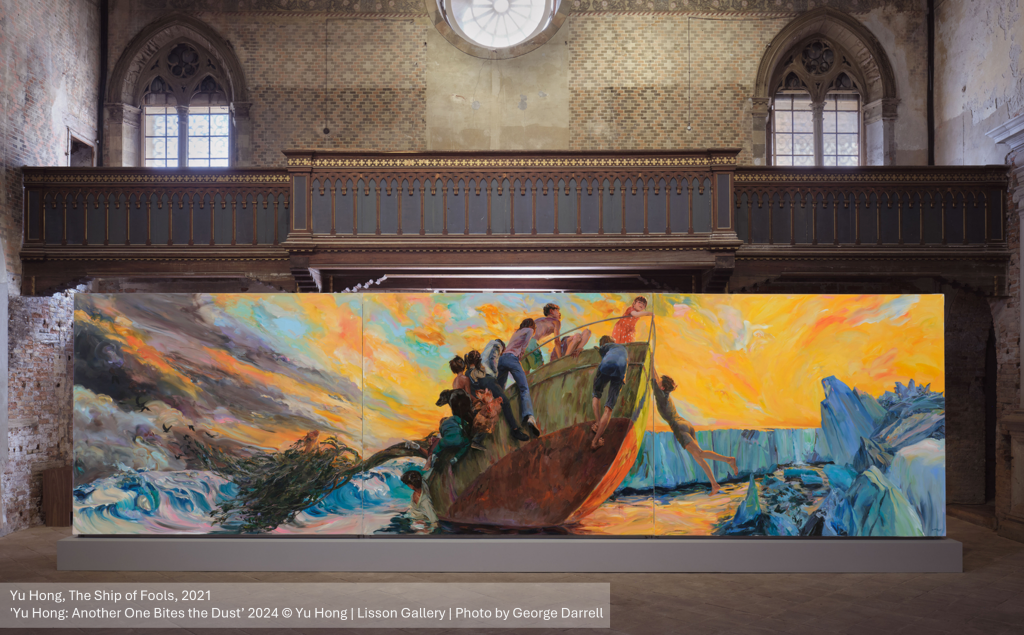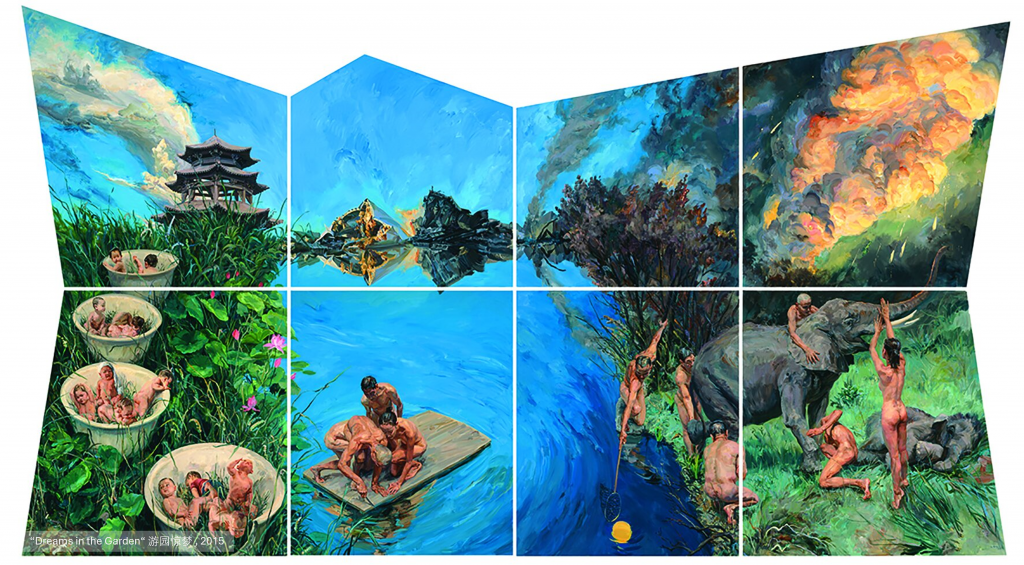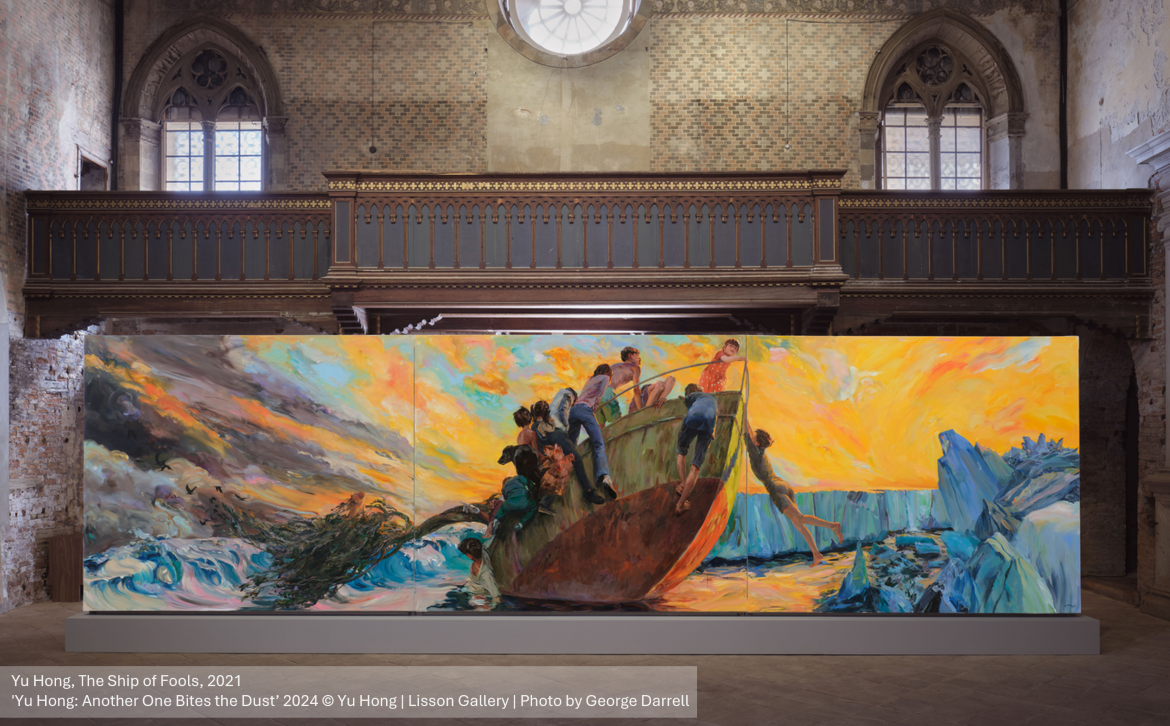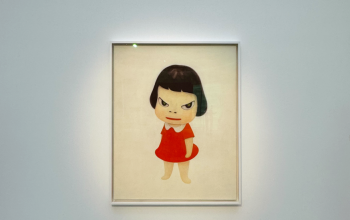In 2022, Chinese artist Yu Hong signed with the renowned Lisson Gallery, a milestone that heralded her works’ appearances at Art Basel over the past two years. Her piece “The Ship of Fools,” showcased in the 2023 Unlimited section, subtly referenced Sebastian Brant’s 1494 publication and Hieronymus Bosch’s artwork of the same name. This work, with its understated references, uses sunlight, soil, and gold tones as its primary palette, reflecting Yu Hong’s recent thematic focus. Her compositions are meticulously structured yet highly readable, exuding a confident demeanor that is remarkable for someone still establishing their presence at Art Basel. Her ambition and ability to captivate audiences bring excitement and anticipation for her future works. I appreciate her spontaneous, straightforward paintings—unpretentious and simply profound.

This year, Yu Hong’s first solo exhibition in Europe, “Another One Bites the Dust,” was unveiled at Chiesetta della Misericordia in the Cannaregio district of Venice. Perhaps this exhibition came a bit late, but it finally arrived. According to Yu Hong, she loves the complexity of people, yet her perspective remains remarkably straightforward. Growing up within the supportive environment of the Central Academy of Fine Arts (CAFA), she only needed to focus on her art, shielded from external pressures by mentors, friends, and her partner.
Yu Hong’s works are imbued with the warmth of a winter fire. Even when the environment depicted is cold, destructive, or perilous, the human subjects in her paintings maintain a state of calm—either asleep or vacant. This disconnection between people and their surroundings evokes a maternal protective shell, preserving the purity of her subjects. In her art, this shell might be a smooth floor, a comfortable sofa, or any container that provides a sense of safety and boundaries.
In contemporary settings, this clean and orderly emotional landscape often clashes with the surrounding chaos and disorder, yet this does not detract from my appreciation of her work. I admire her consistent personal expression over the years: a nuanced, implicit sexual tension within an Eastern cultural context.

Before delving further into this motive, I would like to highlight two recurring figurative paradigms in Yu Hong’s works to explain how these subjective connections are constructed.
The first paradigm is the posture of the body extended into a curve. This can be seen in the hanging figure at the prow of the ship in “The Ship of Fools,” the figure touching an elephant’s trunk in “The Peony Pavilion,” and even in the earlier work “Daily Life – I Am Taking Off My Clothes” from 2002. Imagine a scenario where, after being confined in a cramped space for a period, such as after a long journey, the body yearns for a stretch. Yu Hong once mentioned feeling anxious during the years she was raising her child, resulting in a significant hiatus from painting until she completed the “Witness to Growth” series in 1999. This period of exhaustion and subsequent resurgence is mirrored in the stretching postures in her work.

Yu Hong’s portrayal of repression is unique, focusing more on her changing identity and personal growth. She appears as a transcendent fairy, with the changing environment serving merely as a blurred background to her different phases. I admire her dedication to a personal perspective, resisting the temptation to create works that conform to contemporary expectations. This persistence reflects a genius-level confidence.
The second recurring motif is the posture of women pressing their legs together. This characteristic sharply delineates the restrained sexual tension in her works. After seeing Yu Hong’s straightforward portrayal of desire in “Winter and Spring,” I was initially surprised to find such raw expression in 1993 Beijing. Yet, this authenticity is central to her work. Her depiction of sexual tension is captivating from both male and female perspectives. Unlike Marlene Dumas, whose figures are open and inviting, Yu Hong’s female forms are closed and restrained. This choice transcends traditional cultural stereotypes, suggesting a complex interplay of attraction and resistance.
Marlene Dumas, a South African artist based in Amsterdam, provides an intriguing counterpoint to Yu Hong’s exploration of female identity. Dumas’s works often depict female nudes in a raw, unfiltered manner, challenging conventional notions of beauty and sexuality. Her figures are frequently presented in poses that invite and confront the viewer, establishing a dynamic of power and vulnerability. In contrast, Yu Hong’s figures, with their legs tightly pressed together, suggest a different kind of tension—one that is more introspective and restrained. This inward-looking approach offers a subtle commentary on the complexities of female desire and the implicit constraints that shape it.
An exception to this motif is the female figure in the left middle section of her 2018 work “Heaven and Earth,” depicted with open legs, facing a young girl. This open posture, in conjunction with the presence of the child, presents a different narrative, adding depth to her exploration of female identity.
Finally, let us return to the quote from Lu Xun that Yu Hong references regarding “Another One Bites the Dust”:
“Although ‘a large population’ is something to be proud of with closed eyes, these many people are merely tumbling in the dust. As children, they are not considered human; as adults, they cannot become human.”Lu Xun – Hot Wind/Impressions/Twenty-Five
Lu Xun – Hot Wind/Impressions/Twenty-Five
This quote satirizes the societal environment that stifles the growth of a generation. Viewed through this lens, “The Ship of Fools” shows a multitude of fools, none of whom stand out with any individuality. However, I prefer a different interpretation, one that I believe Yu Hong also embraces. “Tumbling in the dust” is just a starting point. A closer look reveals deeper meanings:
“Otto Weininger, who looked down upon women, divided them into two categories: mothers and whores. Following this logic, men can also be divided into ‘fathers’ and ‘philanderers.’ However, the ‘father’ category can be further divided into two types: one who merely sires children, and one who is a ‘father’ of people. The first type only knows how to procreate, not educate, often carrying the air of a philanderer. The second type not only fathers children but also contemplates how to educate them to become complete individuals.”
Lu Xun – Hot Wind/Impressions/Twenty-Five
Human contribution revolves around sex and procreation, a balance difficult to achieve. Lu Xun criticizes men from a male perspective, highlighting their sexual dominance while evading the responsibilities of raising children. What about Yu Hong? Her answers lie within her art; she embraces it all. Yu Hong’s exhibition “Another One Bites the Dust” profoundly explores human complexity and artistic integrity. By merging personal experiences with broader societal themes, she creates a compelling narrative that resonates deeply with viewers, solidifying her status as a significant figure in contemporary art.



